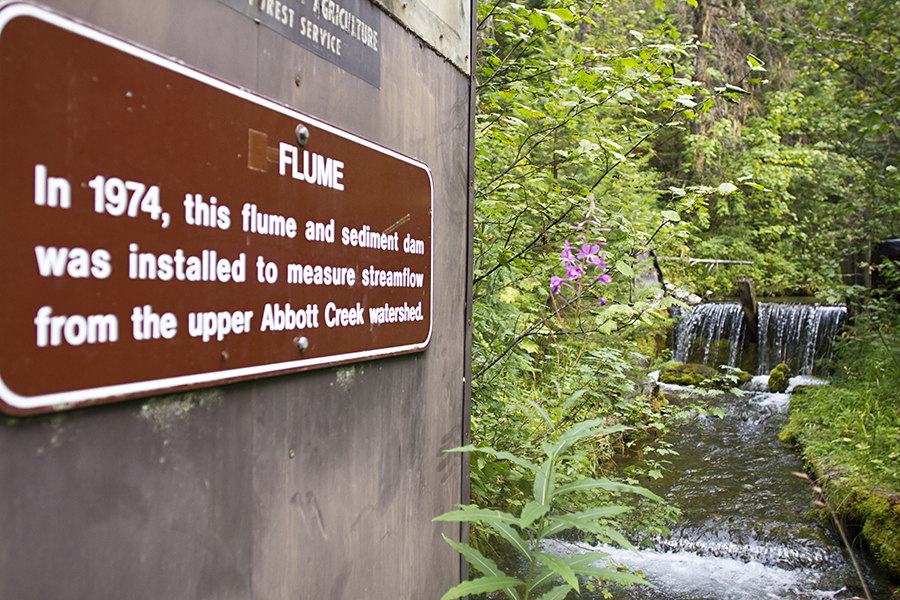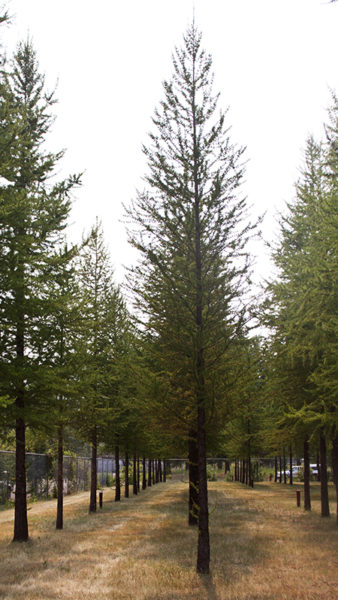In 1976, three Montana foresters published a handbook about the ecology and silviculture, or cultivation, of western larch forests. At the time, virtually zero scientifically based guidelines for growing the species existed, even though more than 1.5 million board feet of western larch was being harvested per year in the northern Rocky Mountains. Over 108 pages, the handbook laid out how private property owners, public land managers, and others could achieve various stand objectives related to tree growth and timber yield through certain seeding, planting, and cutting practices.
Today, silviculturalists — people who influence forest regeneration and composition — still call this handbook “the Bible.” It is the foundation for western larch management. Its principles drew on field research conducted over 30 years, partly in Idaho, but primarily on a 7,460-acre piece of Northwest Montana land, which the book calls “the heart of western larch country.” You’ve probably been there, if you’ve ever driven up the east side of the Hungry Horse Reservoir — a quiet portion of the Spotted Bear road crosses through the property, in the shadow of Desert Mountain near the Abbott Homestead, just outside Martin City. Maybe you’ve seen the sign for the Coram Experimental Forest and wondered.
In 1933, the U.S. Forest Service established this experimental forest on a chunk of quintessential western larch-mixed conifer forest in the Hungry Horse Ranger District of the Flathead National Forest. It became one of 14 experimental forests administered by the Forest Service’s Rocky Mountain Research Station (RMRS), and one of 63 experimental forests nationwide. These areas, set apart from other types of public land, are shielded from controlled thinning, prescribed burning, and other timber management practices. This stasis presents researchers with the unique opportunity to engage in long-term vegetation projects, including ongoing studies in Coram that have been sustained long enough to be an irreplaceable scientific resource within our lifetimes.
The first wave of research on the forest began in 1946, with the Forest Service silviculturalists who produced the handbook, Wyman C. Schmidt, Raymond C. Schearer, and Arthur L. Roe, along with colleagues like Tony Squillace.
“Once you start logging trees, you start wondering how you regenerate,” says Elaine Sutherland, a RMRS biologist and Coram’s scientist in charge. “The original focus [on the experimental forest] was on regenerating larch, and the best ways to grow it.”
These dedicated researchers installed study after study after study in the 60s and 70s. One of Schmidt’s hallmark projects came in 1961, involving differently thinned stands, spaced from as close as 8 feet apart to as far as 20 feet apart. Every five years until 2000, researchers recorded every growth metric that spacing could possibly impact. Eventually, they were able to correlate a tree’s diameter to the density of the stand it was growing in — a finding readily applied by any land manager interested in controlling the size of their larches.
As Flathead National Forest silviculturalist Melissa Jenkins says, the Coram forest has become an “incredible treasure,” as a tangible educational resource for land management. If somebody wants to achieve any objective in a western larch-mixed conifer forest, whether related to timber production or wildlife habitat, they don’t have to wonder how their decisions made today will shape the land beyond our lifetimes, Jenkins says. They can just look to the Coram forest.
In the early years, Coram forest researchers learned about characteristics of young larch forests; the larch stands and data matured in tandem. Study topics on the forest also broadened, with related questions about insect and disease relationships, understory vegetation development, the effects of prescribed burning on stand regeneration, conifer seed dispersal, how soil is impacted by logging and timber removal, and much more.

Over recent decades, however, changes in funding priorities reduced staffing, and the installation of new studies slowed. Today, researchers are limited in their ability even to re-measure Coram’s biggest late-century studies.
While neither Sutherland nor David Wright, a RMRS biologist and the Coram forest’s manager, collect study data or conduct their own silviculture projects on the site, they do ensure that research infrastructure is maintained, existing experimental plots are protected, and weather stations are continually downloading data. Even if studies like the spacing project aren’t necessarily active today, “one thing that’s beneficial about maintaining long-term studies is they can be repurposed” for new studies, Wright explains, which now often come via university partnerships. Coram’s experimental plots, with decades of records, are advantageous in forestry, a slow-moving science.
“There’s not much you can learn [about trees] over a decade,” explains Christopher Keyes, a University of Montana research professor of silviculture. “I very rarely end up initiating new experiments — I’m often jumping onto studies people have started decades ago.” Over just the past three years, he has worked alongside other researchers to publish five papers using new information obtained by revisiting a study installed on Coram in 1974. “If people are starting with a question, and they’re initiating treatments now,” he continues, “they won’t be able to produce results that are interesting for quite a while.”
In 2015, University of Montana associate professor of forest ecology Andrew Larson and Montana Conservation Society Western Montana forester Michael Schaedel, then a grad student, used Schmidt’s 1961 spacing study like a ready-made research site to answer a contemporary question. They re-measured the same growth metrics as scientists before them, updating the record books. But they were most interested in new data: by measuring the amount of carbon that trees had absorbed over 50-plus years, they hoped to understand how different thinning treatments impacted the amount of carbon that larch stands are able to store.
“Forests are an important part of the global carbon cycle, an important reservoir … pulling carbon out of the atmosphere,” Larson says. “What conventional wisdom predicts, and what other research led us to expect, was that in lower density treatments — [stands] with fewer [but bigger] trees — we’d find less total above-ground carbon.”

Instead, they found that the total amount of above-ground carbon stored was equivalent across all of the experimental plots, no matter the density or tree size. “This is incredibly important and relevant to forest management right now,” Larson says. This research shows that forest managers utilizing thinning principles to produce stands with big larches don’t need to make compromises in order to also maximize carbon absorption.
In recent years, the experimental forest has begun participating in a project called Adaptive Silviculture for Climate Change (ASCC), a network of experimental silvicultural trials in different forest ecosystem types across the country. The aim is to evaluate how various management options may enable forests to be more adaptive to the changing climate. For example, Sutherland suggested, increasing spacing between trees may decrease competition for water between them, which could help mitigate some challenges of drier growing seasons. Embarking on what may be a new era of groundbreaking research on the forest, Sutherland often thinks of the Greek proverb about elders who plant trees in whose shade they shall never sit.
“These long-term studies are valuable,” Sutherland says. “They can yield answers to questions that haven’t been thought of yet.”
Read more of our best long-form journalism in Flathead Living. Pick up the fall edition for free on newsstands across the valley.
